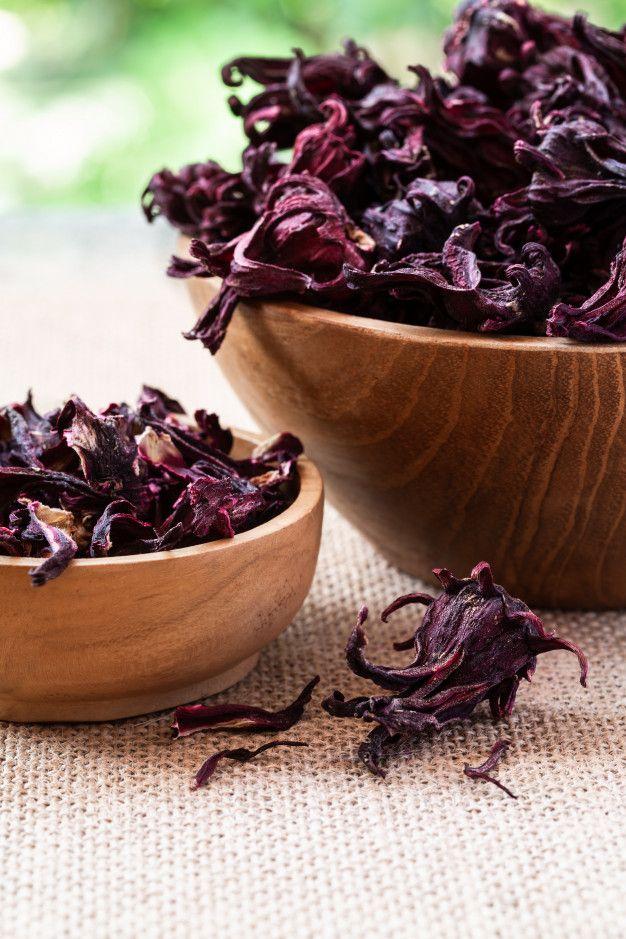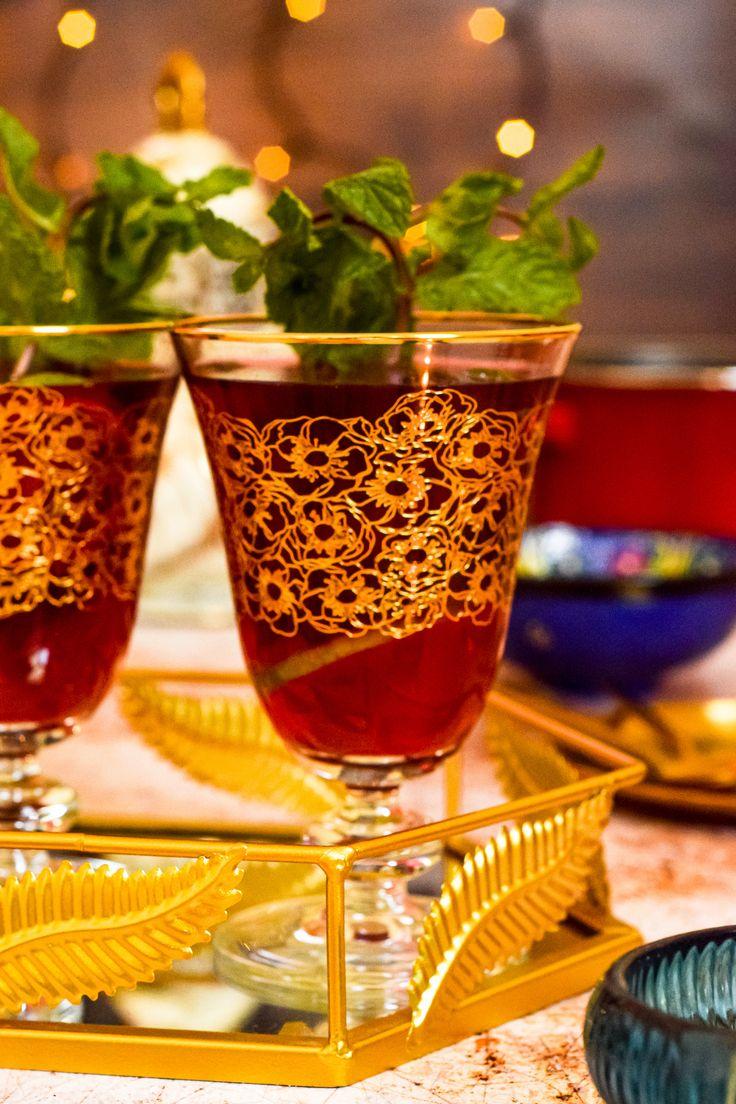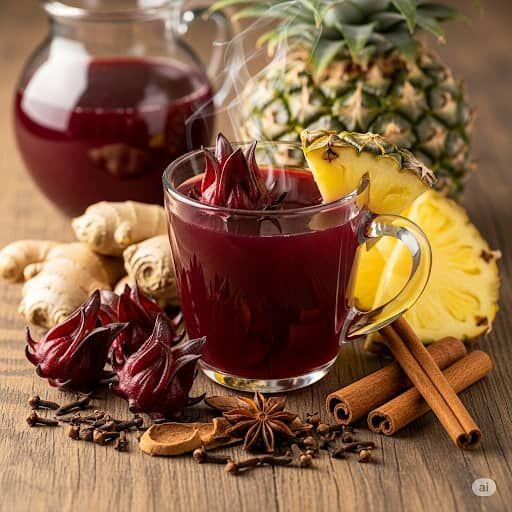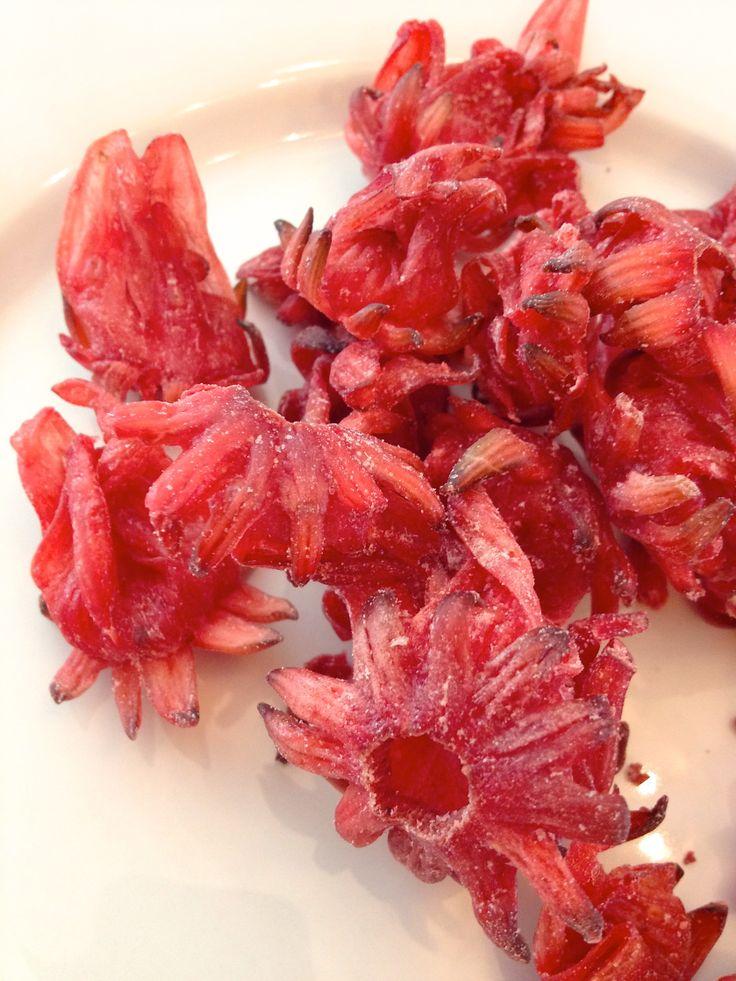There exists a magical plant whose crimson petals are steeped in boiling water, releasing their essence into a ruby-red elixir that has the chemical properties of ambrosia. This plant is Hibiscus sabdariffa, known as Roselle or Sorrel, Africa's botanical gift to the world, and it is far more than just a beautiful flower. Hibiscus weaves together a history of olden wisdom, cultural resilience, and cutting-edge science in a story that spans continents and millennia.
Hibiscus's Journey Through Time

So, it happened that in the heart of Sudan, around 4000 BCE, early African civilizations first recognized hibiscus's potential. The plant existed at first to be cultivated for its protein-rich seeds, roasted like coffee beans or ground into nourishing meal, but it gradually evolved and morphed into something… more. These ancient communities discovered that every part of this plant was something of value: the seeds for sustenance, leaves and shoots for vegetables, and those distinctive fleshy calyces that would become the foundation of a global phenomenon.
This adaptability and the wide range of usable parts from a single plant likely played a significant role in hibiscus's widespread adoption across various African cultures. The progression from initial seed cultivation to broader applications reveals a continuous process of discovery and refinement, positioning hibiscus as a cornerstone of both sustenance and healing.
Perhaps no story better shows hibiscus's cultural power than its journey across the Atlantic during the transatlantic slave trade. When enslaved Africans were torn from their homeland, they carried more than memories; they carried seeds, recipes, and an unbreakable connection to their roots.
In Caribbean soils, hibiscus flourished, and with it, a piece of home survived the unimaginable. The favorable climates allowed the plant to thrive, and enslaved Africans continued to prepare versions of their traditional teas, finding comfort and hope in familiar flavors amid unfamiliar lands.
The "Red Drink" became far more than sustenance. It was comfort in chaos, tradition preserved against impossible odds, and eventually, a powerful symbol of freedom. After Juneteenth, that deep crimson color took on profound new meaning, honoring those who had fallen while celebrating liberation. Each cup connected the present to ancestral wisdom, proving that culture, like hibiscus, adapts and endures.
This transformation of hibiscus from a beloved African beverage into a symbol of resilience and cultural preservation demonstrates how traditional foods and medicinal plants serve as tangible anchors for collective memory and identity, even when communities are forcibly separated from their ancestral lands.
The Pharoah's Holy Brew

Ancient Egypt elevated hibiscus to a status of royalty with the introduction of "Karkadeh", the Tea of the Pharaohs. The Ebers Papyrus, a 3,500-year-old medical text dating back to 1550 BCE, documents its use as a remedy for coughs and other ailments, providing some of humanity's earliest written evidence of hibiscus as medicine.
But this wasn't merely about healing.
Egyptian nobility cherished Karkadeh for its remarkable cooling properties in the desert heat and its distinctive tart, cranberry-like flavor. This ruby elixir became more than refreshment; it was liquid relief, a social ritual, and a symbol of prosperity.
The tradition runs so deep that Egyptian weddings still feature Karkadeh toasts today, glasses raised high with ruby liquid symbolizing vitality and joy, connecting modern celebrations to pharaonic customs across millennia.
Hibiscus in a Cup
Today, hibiscus paints Africa's beverage landscape in brilliant red shades, with each region adding its own signature to this old recipe. The core ingredient remains consistent, but its formula is deeply localized, demonstrating a dynamic interplay between a versatile plant and diverse cultural contexts.

Zobo is a Nigerian drink that transforms simple hibiscus into liquid hospitality. This vibrant, tangy beverage is widely recognized as a symbol of hospitality and communal bonding. Preparation involves steeping dried hibiscus petals in water, often spiced with ginger, cinnamon, cloves, and black pepper. Modern variations frequently incorporate local fruits such as pineapple, orange, or watermelon, which enhance both flavor and nutritional value. Zobo isn't just served, it's shared. From family gatherings to weddings, this beverage embodies community, bringing people together over glasses of refreshment. While traditionally enjoyed chilled, it can also be served hot, and for adult celebrations, a splash of rum sometimes adds festive flair.
Bissap holds national treasure status in Senegal and The Gambia, its tangy-sweet flavor often compared to premium cranberry juice. The preparation typically involves boiling dried hibiscus petals with fresh mint leaves, ginger, lemon, or lime, then sweetening with sugar. Although predominantly served cold, Bissap is also consumed hot as a remedy when feeling unwell. Bissap appears at naming ceremonies when children are born and fills school canteens across the region, weaving itself into daily life from the most precious moments to everyday refreshment.
Sobolo belongs to Ghana and continues this West African tradition with its own distinctive character, frequently prepared with ginger and pineapple flavoring to create a healthy, sweet beverage that's become a beloved local staple.
Karkadeh of the Egyptians or Sudanese maintains its legacy, served hot or cold and sweetened with sugar or honey. Its traditional value lies not only in its cooling properties, particularly crucial in hot climates, but also in its ceremonial role in celebrations like wedding toasts.
Karkanji is a variant from Chad that offers a refreshing variation, prepared by boiling hibiscus flowers with water, sugar, and often ginger root or aromatic combinations of cinnamon and cloves. This widely consumed drink is commonly sold by the glass throughout Chad, providing an affordable and satisfying thirst quencher that locals believe helps combat colds.
Hibiscus Beyond the Cup
Hibiscus refuses to be confined to beverages; its versatility also shows across African culinary traditions. The seeds are traditionally roasted or ground into meal, serving as a nutritional staple. Its young leaves and tender shoots are consumed raw or cooked, functioning as vegetables or condiments in many different cuisines.

Green hibiscus leaves season traditional dishes like thiéboudienne and yassa poulet, often enhanced with salt, lemon, and okra. The fleshy calyces find their way into jellies, jams, chutneys, sauces, wines, soups, and pickles. Hibiscus flowers transform into exotic prawn marinades combined with chili, ginger, and sumac, or brighten vibrant okra-mango salads.
Creative modern applications include hibiscus drizzle for puff puff (popular fried dough snacks), unique jams like strawberry-hibiscus or sugar-free rosella varieties, and even nourishing soups such as Blue Congo potato and hibiscus flower soup or quinoa and hibiscus combinations, innovations that would surprise anyone expecting just another floral tea.
Hibiscus is Nature's Pharmacy
For millennia, African healers have prescribed hibiscus for an array of ailments: high blood pressure, cholesterol imbalances, sore throats, coughs, respiratory conditions, digestive issues, fever reduction, and even topical applications for skin healing. In Sudan, it's employed against microbial infections, while in Ghana, it's believed to regulate menstrual periods and reduce cramps. Today's laboratories are proving these traditional healers were remarkably prescient, with contemporary research increasingly validating many of hibiscus's long-held therapeutic applications.
1. Cardiovascular Champion
Science has confirmed what traditional healers always knew: hibiscus is a heart's best friend. Rigorous studies demonstrate that hibiscus tea can lower both systolic and diastolic blood pressure through multiple sophisticated mechanisms, acting as a natural vasodilator, gentle diuretic, and ACE inhibitor. Some research indicates effects comparable to certain pharmaceutical drugs, with the added benefit that its diuretic action doesn't appear to alter potassium levels like some conventional medications.
Even more impressive, hibiscus plays a significant role in managing hyperlipidemia by reducing total cholesterol, LDL cholesterol, and fasting plasma glucose. Its rich content of anthocyanins and flavonoids acts as potent antioxidants, inhibiting LDL-C oxidation, a critical step in atherosclerosis development, thereby contributing to comprehensive cardiovascular protection.
2. Antioxidant Powerhouse
Hibiscus doesn't just look beautiful, it's rich in antioxidants, particularly anthocyanins (such as delphinidin-3-O-sambubioside and cyanidin-3-O-sambubioside) and polyphenols (including protocatechuic acid and quercetin). These compounds wage war against free radicals and inflammation, reducing markers like IL-1 and TNF-α while protecting everything from skin collagen to cellular DNA.
This protective action goes beyond basic antioxidant effects, supporting skin health by preventing collagen damage and maintaining overall cellular integrity throughout the body.
3. Metabolic Magic and Weight Management
Modern research reveals hibiscus's ability to regulate blood sugar levels and enhance insulin sensitivity. Its potential role in obesity management is attributed to its capacity to inhibit lipid accumulation and suppress adipogenesis. Additionally, hibiscus demonstrates alpha-amylase inhibitory activity, which July contribute to decreased glucose absorption, making it a valuable ally in comprehensive metabolic health management.
4. Immune and Digestive Support
Hibiscus's nutritional profile contributes to gut health and immune function. As an excellent source of dietary fiber (up to 33% in powder form), it supports the proliferation of beneficial gut bacteria. Its calcium content aids digestive enzyme function, while its iron is essential for mounting effective immune responses and contributes to normal red blood cell formation and oxygen transport, thereby boosting energy levels and reducing tiredness and fatigue.
Hibiscus's Nutritional Treasure Trove
The numbers tell an impressive story that validates hibiscus as functional nutrition in liquid form:
Macronutrients and Vitamins: Hibiscus provides substantial dietary fiber, protein (4-5% in calyces and leaves, 20-30% in seeds), and is notably rich in Vitamin C (up to 94% in leaves), Vitamin A (beta-carotene), and B-complex vitamins including thiamine, riboflavin, and niacin.
Essential Minerals: The plant is exceptionally rich in calcium, iron, magnesium, phosphorus (often the most abundant mineral), potassium, manganese, and copper—all crucial for various physiological functions from bone health to energy metabolism.
Bioactive Compounds: Hibiscus contains an impressive pharmacy of beneficial phytochemicals, with extracts rich in tannins (17.0%), saponins (0.96%), phenols (1.1%), flavonoids (20.08%), and alkaloids (2.14%). The phenolic content of rosella petals can reach as high as 60% by weight.
The Synergy of Hibiscus
Here's where hibiscus gets fascinating from a scientific perspective: unlike pharmaceutical drugs that rely on single active compounds, hibiscus works through what researchers call "synergistic interactions." The whole plant offers a broader spectrum of benefits due to complex interactions between numerous components, benefits that simplified extracts might miss.
This phenomenon reveals a fundamental difference between traditional ethnobotanical practices, which utilize whole plants, and modern pharmacological research, which seeks to isolate active compounds. The "whole plant" approach might capture therapeutic complexities that conventional clinical trials, designed for single-compound drugs, cannot fully evaluate.
Research indicates broad-spectrum antimicrobial activity for hibiscus, showing efficacy against various bacterial strains, including foodborne pathogens, with activity comparable to some antibiotics. The plant exhibits hepatoprotective effects, safeguarding liver cells from oxidative damage, and demonstrates nephroprotective activity for kidney health.
Other studies also suggest potential anti-cancer properties through mechanisms like inducing apoptosis and chemoprevention, though these areas still require more robust human clinical data for definitive therapeutic recommendations.
Hibiscus's Modern Application
Today, hibiscus stands at the intersection of tradition and innovation. Health-conscious consumers worldwide are discovering what African cultures have known for millennia, that this ruby-red elixir offers both pleasure and immense wellness benefits.
From artisanal tea blends in specialty shops to functional beverages in health food stores, hibiscus is experiencing a global renaissance. Its journey from ancient Sudanese cultivation to modern supermarket shelves represents not just botanical success but the validation of traditional knowledge systems that preserved and refined this wisdom across millennia.
Conclusion
Hibiscus sabdariffa represents far more than botanical or commercial success; it embodies human resilience, cultural continuity, and the profound bridge between ancient wisdom and modern scientific validation. From Sudan's early cultivators to today's health-conscious global consumers, this remarkable plant has consistently delivered both sensory pleasure and therapeutic wellness.
As research continues unveiling hibiscus's therapeutic potential, from proven cardiovascular benefits to promising antimicrobial and metabolic effects, we're reminded that some of humanity's most valuable medicines have been hiding in plain sight, steeping in our teacups and flavoring our celebrations for thousands of years.
In every ruby-red cup lies a story 6,000 years in the making: of African ingenuity, cultural preservation, scientific validation, and nature's generous pharmacy. Hibiscus isn't just surviving the modern world; it's thriving in it, proving that the most enduring innovations often come not from laboratories, but from listening carefully to the wisdom our ancestors have been sharing all along.
The next time you raise a glass of hibiscus tea, remember: you're not just drinking a beverage, you're participating in one of humanity's oldest wellness traditions, connecting across time and culture through the simple act of sharing nature's ruby gift, one crimson sip at a time.
References
- Aduna. n.d. “The Top Benefits of Hibiscus.” Accessed July 22, 2025. https://aduna.com/blogs/learn/the-top-benefits-of-hibiscus
- Allrecipes. n.d. “Karkadeh Egyptian Hibiscus Iced Tea.” Accessed July 22, 2025. https://www.allrecipes.com/recipe/264551/karkadeh-egyptian-hibiscus-iced-tea/
- Australian Medicinal Herbs. 2025. “Hibiscus Sabdariffa: A Historical Perspective.” Last modified January 18, 2025. https://australianmedicinalherbs.com.au/blogs/news/hibiscus-sabdariffa-a-historical-perspective
- Balarabe, Muhammad Auwal. 2019. “Nutritional Analysis of Hibiscus sabdariffa L. (Roselle) Leaves and Calyces.” Journal of Applied Biology & Biotechnology 7, no. 06: 63–66
- Food.com. n.d. “Karkanji-Hibiscus Tea - Africa Recipe.” Accessed July 22, 2025. https://www.food.com/recipe/karkanji-hibiscus-tea-africa-455446
- Fourcarrockcourt. n.d. “Bissap Hibiscus Juice.” Accessed July 22, 2025. https://fourcarrockcourt.com/bissap-hibiscus-juice/
- Ghanas Fresh. n.d. “Hibiscus Leaves Tea.” Accessed July 22, 2025. https://ghanasfresh.com/product/hibiscus-tea/
- Kemet Market. n.d. “Les secrets culinaires et médicinaux de la fleur de bissap, le super aliment coloré.” Accessed July 22, 2025. https://kemetmarket.com/en/blogs/blog/les-secrets-culinaires-et-medicinaux-de-la-fleur-de-bissape-le-super-aliment-colore
- Moody Teas. 2023. “Hibiscus and Black History: From Sorrel to Jamaica.” Last modified February 17, 2023. https://moodyteas.co/2023/02/17/hibiscus-black-history/
- ProVeg. n.d. “Zobo Drink.” Accessed July 22, 2025. https://proveg.org/ng/recipes/zobo-drink/
- Serious Eats. n.d. “Hibiscus-Pineapple Skin “Tea”.” Accessed July 22, 2025. https://www.seriouseats.com/hibiscus-pineapple-skin-drink-5184253
- Sudanese Kitchen. n.d. “Karkadey.” Accessed July 22, 2025. https://www.sudanese.kitchen/recipe/karkadey
- Tastes from the Road. n.d. “Bissap from West Africa.” Accessed July 22, 2025. https://www.tastesfromtheroad.com/recipes/bissap-from-west-africa
- The Afropolitan Mom. n.d. “Zobo Drink.” Accessed July 22, 2025. https://www.theafropolitanmom.com/zobo-drink/
- Tonipayneosha. n.d. “Zobo: Nigeria’s Hibiscus Infusion – A Culinary and Cultural Delight.” Accessed July 22, 2025. https://tonipayneosha.com/biodiversity-report/zobo-nigerias-hibiscus-infusion-a-culinary-and-cultural-delight/#:~:text=Cultural%20Significance&text=It%20is%20not%20merely%20a,limited%20to%20a%20specific%20demographic
- Weight Clinic at FP Greeley. 2025. “Discovering Zobo: A Refreshing Tradition with Health Benefits.” Last modified July 4, 2024. https://weightclinicatfpgreeley.com/2024/07/04/discovering-zobo-a-refreshing-tradition-with-health-benefits-2/
- Wikipedia. n.d. “Hibiscus Tea.” Accessed July 22, 2025. https://en.wikipedia.org/wiki/Hibiscus_tea
Join the Oriire Community
Become a free member to bookmark your favorite stories, join the discussion and personalize your experience.
















Share
0 Comments